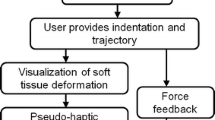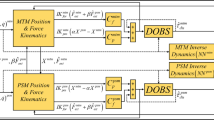Abstract
Background
The loss of tactile feedback in minimally invasive robotic surgery remains a major challenge to the expanding field. With visual cue compensation alone, tissue characterization via palpation proves to be immensely difficult. This work evaluates a bimodal vibrotactile system as a means of conveying applied forces to simulate haptic feedback in two sets of studies simulating an artificial palpation task using the da Vinci surgical robot.
Methods
Subjects in the first study were tasked with localizing an embedded vessel in a soft tissue phantom using a single-sensor unit. In the second study, subjects localized tumor-like structures using a three-sensor array. In both sets of studies, subjects completed the task under three trial conditions: no feedback, normal force tactile feedback, and hybrid vibrotactile feedback. Recordings of correct localization, incorrect localization, and time-to-completion were used to evaluate performance outcomes.
Results
With the addition of vibrotactile and pneumatic feedback, significant improvements in the percentage of correct localization attempts were detected (p = 0.0001 and p = 0.0459, respectively) during the first experiment with phantom vessels. Similarly, significant improvements in correct localization were found with the addition of vibrotactile (p = 2.57E−5) and pneumatic significance (p = 8.54E−5) were observed in the second experiment involving tumor phantoms.
Conclusions
This work demonstrates not only the superior benefits of a multi-modal feedback over traditional single-modality feedback, but also the effectiveness of vibration in providing haptic feedback to artificial palpation systems.







Similar content being viewed by others
References
Puangmali P, Liu H, Seneviratne LD, Dasgupta P, Althoefer K (2012) Miniature 3-axis distal force sensor for minimally invasive surgical palpation. IEEE/ASME Trans Mechatron 17(4):646–656. https://doi.org/10.1109/TMECH.2011.2116033
Ahmadi R, Packirisamy M, Dargahi J, Cecere R (2012) Discretely loaded beam-type optical fiber tactile sensor for tissue manipulation and palpation in minimally invasive robotic surgery. IEEE Sens J 12(1):22–32. https://doi.org/10.1109/JSEN.2011.2113394
Wagner CR, Stylopoulos N, Howe RD (2002) The role of force feedback in surgery: analysis of blunt dissection. In: Proceedings of 10th symposium on haptic interfaces virtual environment and teleoperator systems (HAPTICS), pp 68–74. https://doi.org/10.1109/HAPTIC.2002.998943
Bethea BT, Okamura AM, Kitagawa M et al (2004) Application of haptic feedback to robotic surgery. J Laparoendosc Adv Surg Tech 14(3):191–195. https://doi.org/10.1089/1092642041255441
Diks J, Nio D, Linsen MA, Rauwerda JA, Wisselink W (2007) Suture damage during robot-assisted vascular surgery: is it an issue? Surg Laparosc Endosc Percutan Tech 17(6):524–527. https://doi.org/10.1097/SLE.0b013e318150e590
Van Der Meijden OAJ, Schijven MP (2009) The value of haptic feedback in conventional and robot-assisted minimal invasive surgery and virtual reality training: a current review. Surg Endosc Other Interv Tech 23(6):1180–1190. https://doi.org/10.1007/s00464-008-0298-x
Nitsch V, Farber B (2013) A meta-analysis of the effects of haptic interfaces on task performance with teleoperation systems. IEEE Trans Haptics 6(4):387–398. https://doi.org/10.1109/TOH.2012.62
Ahn B, Lorenzo EIS, Rha KH, Kim HJ, Kim J (2011) Robotic palpation-based mechanical property mapping for diagnosis of prostate cancer. J Endourol 25(5):851–857. https://doi.org/10.1089/end.2010.0468
Okamura AM, Simone C, O’Leary MD (2004) Force modeling for needle insertion into soft tissue. IEEE Trans Biomed Eng 51(10):1707–1716. https://doi.org/10.1109/TBME.2004.831542
Schostek S, Ho C-N, Kalanovic D, Schurr MO (2006) Artificial tactile sensing in minimally invasive surgery—a new technical approach. Minim Invasive Ther Allied Technol 15(5):296–304. https://doi.org/10.1080/13645700600836299
Ottermo MV, Stavdahl Ø, Johansen TA (2009) A remote palpation instrument for laparoscopic surgery: design and performance. Minim Invasive Ther Allied Technol 18(1):259–272. https://doi.org/10.1080/13645700903202314
Menciassi A, Eisinberg A, Carrozza MC, Dario P (2003) Force sensing microinstrument for measuring tissue properties and pulse in microsurgery. IEEE/ASME Trans Mechatron 8(1):10–17. https://doi.org/10.1109/TMECH.2003.809153
Ottermo MV, Stavdahl O, Johansen TA (2004) Palpation instrument for augmented minimally invasive surgery. IEEE/RSJ Int Conf Intell Robot Syst (IEEE Cat No04CH37566) 4:3–7. https://doi.org/10.1109/IROS.2004.1390033
Kitagawa M, Dokko D, Okamura AM, Yuh DD (2005) Effect of sensory substitution on suture-manipulation forces for robotic surgical systems. J Thorac Cardiovasc Surg 129(1):151–158. https://doi.org/10.1016/j.jtcvs.2004.05.029
Meli L, Pacchierotti C, Prattichizzo D (2014) Sensory subtraction in robot-assisted surgery: fingertip skin deformation feedback to ensure safety and improve transparency in bimanual haptic interaction. IEEE Trans Biomed Eng 61(4):1318–1327. https://doi.org/10.1109/TBME.2014.2303052
Koehn JK, Kuchenbecker KJ (2015) Surgeons and non-surgeons prefer haptic feedback of instrument vibrations during robotic surgery. Surg Endosc Other Interv Tech 29(10):2970–2983. https://doi.org/10.1007/s00464-014-4030-8
Samur E, Sedef M, Basdogan C, Avtan L, Duzgun O (2007) A robotic indenter for minimally invasive measurement and characterization of soft tissue response. Med Image Anal 11(4):361–373. https://doi.org/10.1016/j.media.2007.04.001
Kandel ER, Schwartz JH, Jessell TM (2000) Principles of neural science. Neurology. https://doi.org/10.1036/0838577016
King C-H, Higa AT, Culjat MO et al (2007) A pneumatic haptic feedback actuator array for robotic surgery or simulation. Stud Health Technol Inform 125:217–222
Wottawa CR, Genovese B, Nowroozi BN et al (2016) Evaluating tactile feedback in robotic surgery for potential clinical application using an animal model. Surg Endosc 30(8):3198–3209. https://doi.org/10.1007/s00464-015-4602-2
King CH, Culjat MO, Franco ML et al (2009) Tactile feedback induces reduced grasping force in robot-assisted surgery. IEEE Trans Haptics 2:103–110. https://doi.org/10.1109/TOH.2009.4
Mangiafico SS (2017) R handbook: one-way repeated ordinal ANOVA with CLMM. http://rcompanion.org/handbook/G_08.html. Accessed 6 May 2017
Hagen ME, Meehan JJ, Inan I, Morel P (2008) Visual clues act as a substitute for haptic feedback in robotic surgery. Surg Endosc 22(6):1505–1508. https://doi.org/10.1007/s00464-007-9683-0
Lamata P, Gómez EJ, Sánchez-Margallo FM, Lamata F, Del Pozo F, Usón J (2006) Tissue consistency perception in laparoscopy to define the level of fidelity in virtual reality simulation. Surg Endosc Other Interv Tech 20(9):1368–1375. https://doi.org/10.1007/s00464-004-9269-z
Deziel DJ, Millikan KW, Economou SG, Doolas A, Ko S-T, Airan MC (2017) Complications of laparoscopic cholecystectomy: a national survey of 4,292 hospitals and an analysis of 77,604 cases. Am J Surg 165(1):9–14. https://doi.org/10.1016/S0002-9610(05)80397-6
Alleblas CCJ, Vleugels MPH, Nieboer TE (2016) Ergonomics of laparoscopic graspers and the importance of haptic feedback: the surgeons’ perspective. Gynecol Surg 13(4):379–384. https://doi.org/10.1007/s10397-016-0959-z
Abouei Mehrizi A, Moini M, Afshari E, Kadkhodapour J, Sadjadian A, Najarian S (2014) Application of artificial palpation in vascular surgeries for detection of peripheral arterial stenosis. J Med Eng Technol 38(4):169–178. https://doi.org/10.3109/03091902.2014.891663
Afshari E, Najarian S, Simforoosh N (2010) Application of artificial tactile sensing approach in kidney-stone-removal laparoscopy. Bio-Med Mater Eng 20:261–267. https://doi.org/10.3233/BME-2010-0640
Dalvand MM, Shirinzadeh B, Nahavandi S, Smith J (2014) Effects of realistic force feedback in a robotic assisted minimally invasive surgery system. Minim Invasive Ther Allied Technol 23(3):127–135. https://doi.org/10.3109/13645706.2013.867886
Moradi Dalvand M, Shirinzadeh B, Shamdani AH, Smith J, Zhong Y (2014) An actuated force feedback-enabled laparoscopic instrument for robotic-assisted surgery. Int J Med Robot Comput Assist Surg 10(1):11–21. https://doi.org/10.1002/rcs.1503
Bark K, McMahan W, Remington A et al (2013) In vivo validation of a system for haptic feedback of tool vibrations in robotic surgery. Surg Endosc Other Interv Tech 27(2):656–664. https://doi.org/10.1007/s00464-012-2452-8
Giabbiconi C-M, Trujillo-Barreto NJ, Gruber T, Müller MM (2007) Sustained spatial attention to vibration is mediated in primary somatosensory cortex. Neuroimage 35(1):255–262. https://doi.org/10.1016/j.neuroimage.2006.11.022
Funding
The funding was provided by National Institute of Biomedical Imaging and Bioengineering (Grant No. R01EB019473).
Author information
Authors and Affiliations
Corresponding author
Ethics declarations
Disclosures
Dr. Erik Dutson is on Scientific Advisory board of Titan Medical. Drs. Abiri, Juo, Bisley, Dutson, Grundfest, Anna Tao, Syed Askari, and Jake Pensa have no conflicts of interest or financial ties to disclose.
Rights and permissions
About this article
Cite this article
Abiri, A., Juo, YY., Tao, A. et al. Artificial palpation in robotic surgery using haptic feedback. Surg Endosc 33, 1252–1259 (2019). https://doi.org/10.1007/s00464-018-6405-8
Received:
Accepted:
Published:
Issue Date:
DOI: https://doi.org/10.1007/s00464-018-6405-8




